

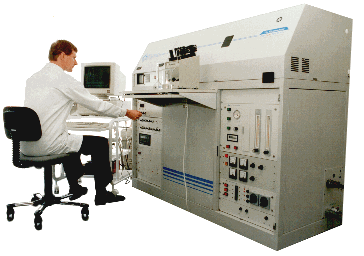
 |
| Wähle Deutsche Fassung |
Our Speciality: Determination of Element Concentrations and Isotope Ratios down to the Ultra Trace Region.
Spurenanalytisches Laboratorium Dr. Baumann is a neutral and independent analytical laboratory dedicated to provide reliable analyses of a vast variety of organic and inorganic matrices, such as
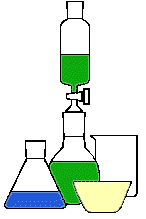
Quality assurance of ultra pure chemicals, as for instance the determination of the uranium and thorium contents of quartz, requires limits of detection in the lower ppb or even ppt range. Tracking and prospecting the deposits of precious metals expect a great deal from analytical chemistry. The analysis of environmental samples, such as air samples from remote areas, demands for more and more sensitive analytical methods. As far as medicine and biology are concerned, sensitive analytical methods are of great advantage, too. This may be the case, for instance, when a large number of heavy metals or trace elements have to be determined in a small volume of whole blood or blood serum. Similar applies for the analysis of food stuffs. The determination of the iodine content in milk or the multielement determination in drinking-water or mineral water are examples for our performance in this area of analytical chemistry.
Spurenanalytisches Laboratorium Dr. Baumann is equipped with some of the most powerful analytical instrumentation (Plasma Source Mass Spectrometry; ICP-MS) and specialized in the determination of element concentrations and isotope ratios down to the ultratrace region. At that, we are able to determine approximately 80 % of the elements of the periodic table.
Founded in 1991, Spurenanalytisches Laboratorium Dr. Baumann has a wealth of expertise in that special area of elemental and isotopic analytical chemistry. We can assure you of accurately and competently dealing with your analytical problems.
We perform both routine and special case analyses. We also offer our services to companies and laboratories which themselves posses some basic analytical instrumentation but fail to resolve some special analytical problems.
| Home |

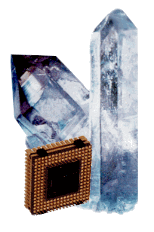
Materials used for the production of electronic devices such as semiconductors have to meet high quality standards. High purity quartz for instance is used as a filler in the encapsulation of discrete and integrated circuit devices. Alpha particles emitted by trace amounts of naturally occurring radioactive isotopes in the quartz can cause so-called soft-errors in the chips. Therefore, the sensitive and reliable determination of these radioactive trace impurities is of crucial importance.
Uranium concentrations of less than 1 ng/g and thorium concentrations of less than 6 ng/g are discussed as the upmost level tolerable in the semiconductor industry. Leading suppliers of high purity quartz fillers specify even lower concentrations.
Spurenanalytisches Laboratorium Dr. Baumann is able to reliably determine those crucial elements at concentrations well below 1 ppb. The limit of detection is in the range of 10 ppt per element. In addition to uranium and thorium the concentrations of a large number of other elements present as trace impurities in the quartz can be determined down to the lower ppb or even ppt-range. The following table presents the results of some quartz analyses:
| Sample Number |
U-concentration [ppm] |
Th-concentration [ppm] | ||
|---|---|---|---|---|
| Quartz #1 | 0.67 | (0.60) | 0.97 | (0.91) |
| Quartz #2 | 0.033 | (0.03) | 0.014 | (0.014) |
| Quartz #3 | 0.0002 | (<0.0017) | 0.0002 | (0.0003) |
(analyses by I-NAA)
High purity solvents, especially inorganic acids such as hydrofluoric acid, hydrochloric acid and nitric acid, which are employed in the production of microchips have to meet extremely high quality standards.
Spurenanalytisches Laboratorium Dr. Baumann achieves limits of detection below 1 ng/ml for most of the elements (for instance Li, Be, Ti, V, Cr, Mn, Co, Ni, Cu, Zn, Rb, Sr, Y, Zr, Nb, Mo, Ru, Rh, Pd, Ag, Cd, In, Sn, Sb, Ba, La, Ce, Ta, W, Re, Os, Ir, Pt, Tl, Pb, Bi, Th, U ) in the above mentioned acids. The concentrations of Na, Mg, K, Ca and Fe can be determined at concentrations down to 1 ng/ml.
| Home |


The determination of various elements in aerosols has become an important task of environmental analytical chemistry. Quite often, little sample material is available for this purpose. This may be the case, for instance, when a short-period pollution event has to be recorded or after the sampling of an aerosol in a remote pure area. In such cases reliable and sensitive analytical tools are required.
Spurenanalytisches Laboratorium Dr. Baumann is able to determine a vast number of elements in air or other aerosols after collection of particulate matter on aerosol filters. Many heavy metals for instance can be determined at concentrations of 1 ng/m3 and below. The following table shows the contents of the airborne particulates collected from a remote pure area:
| Element | Concentration [ng/m3] | |
|---|---|---|
| Antimony | 0.17 | ( 0.12) |
| Lead | 2.00 | |
| Cadmium | 0.23 | |
| Cobalt | 0.05 | ( 0.03) |
| Iron | 19.90 | (19.90) |
| Nickel | 1.00 | ( 0.50) |
| Zinc | 3.80 | (3.00) |
( ) Results obtained by I-NAA
| Home |

Iodine has been known to be necessary to human nutrition for a long time. On the other hand, the daily uptake of iodine is recommended not to exceed certain limits.

In agriculture iodine containing compounds are used for the disinfection of the udders of cows. These compounds should not contaminate the milk of the treated cows. The exact and reliable determination of iodine in milk is therefore of great importance.
Spurenanalytisches Laboratorium Dr. Baumann is able to quickly and reliably determine the concentration of iodine in milk down to the lower ng/g-range. Besides iodine, a vast number of elements can routinely be determined in milk and in different other foodstuffs. The following table summarizes the results of the analyses of two fresh milk samples and one milk powder standard reference material (BCR CRM 150):
| Sample Name | I-Concentration [ppm] | |
|---|---|---|
| analysed | certified | |
| Pure Milk | 0.05 | - |
| Contaminated Milk | 2.2 | - |
| BCR CRM 150 | 1.21 | 1.29 |
Further informations on foodstuffs can be obtained in "Heavy Metals in Wine".
| Home |

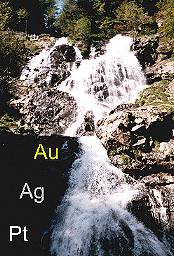
Humus matrix can contain both exotic gold (strongly bound) and indigenous gold (weakly bound). In general, the fraction of weakly bound gold, which can be extracted with diluted mineral acids, increases with proximity to bedrock gold mineralization. Such, the determination of this extractable gold fraction facilitates the exploration of gold mineralization.
The gold concentrations in the extraction solutions usually are in the range of one ppb or less. Therefore, the analytical instruments applied for these analyses have to achieve extremely low limits of detection. Spurenanalytisches Laboratorium Dr. Baumann is able to achieve these limits of detection and to perform reliable analyses supporting the exploration of precious metals deposits.
| Home |

Because of the public interest, mineral waters and drinking-waters are routinely examined with regard to their content of toxic heavy metals. It is less commonly known that wine, too, can contain comparable high amounts of heavy metals - depending on the geochemistry of the region the plant was grown. Some wine samples which had been analysed by us contained heavy metal concentrations close to or even above the limits of the German Drinking-Water Ordinance (Trinkwasser-Verordnung, TrinkwV):
| Wine #1 California |
Wine #2 Rheinpfalz |
TrinkwV | ||
|---|---|---|---|---|
| Lithium | 0.04 | 0.005 | mg/l | |
| Nickel | 0.03 | 0.02 | 0.02 | mg/l |
| Copper | 0.09 | 0.14 | 2 | mg/l |
| Arsenic | 0.02 | 0.01 | 0.01 | mg/l |
| Lead | 0.01 | 0.05 | 0.01 | mg/l |
| Uranium | 0.002 | 0.001 | mg/l |
| Home |

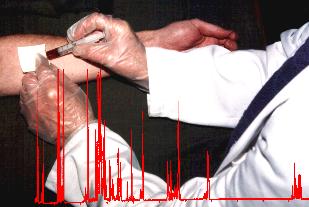
The determination of trace element concentrations in whole blood has gained an ever increasing account in clinical chemistry. Many elements are essential to living organisms at lower concentration ranges. At higher concentrations toxic effects prevail. The fast and reliable determination of element burden is therefore of great importance.
Spurenanalytisches Laboratorium Dr. Baumann can routinely determine the concentrations of a number of elements in whole blood down to the lower ng/ml-range from merely 1 to 2 ml of blood. Especially the most important heavy metals can be determined at toxic levels as well as at clinical concentrations. Moreover, because of the small sample consumption even for multielement determinations, the acquisition of the blood sample is considerate of the test persons. The following table summarizes limits of detection and clinical concentration ranges of some trace elements in whole blood:
| Element | Limit of Detection [ng/ml] |
Clinical Range [ng/ml] |
|---|---|---|
| Arsenic | 20 | 2 - 60 |
| Gold | 2 | <100 |
| Copper | 3 | 700-1500 |
| Thallium | 1 | <10 |
| Zinc | 30 | 700-1400 |
Elemental contents in hair or finger nails can be helpful for the diagnosis of diseases as well as for establishing the uptake of poisons in food or in the environment. Especially heavy metals are enriched in hair and finger nails. In Japan, where consumption of fish is in general higher than in Germany, higher mercury concentrations can be found in finger nails. Hair and finger nails of smokers contain increased cadmium and thallium concentrations. An increase in copper concentrations can be caused by taps made of copper or by the consumption of beer brewed in copper kettles. The following table shows the concentrations of some heavy metals determined in finger nails from German and Japanese people.
| Element | Germany [ppm] |
Japan [ppm] |
|---|---|---|
| Arsenic | < 0.02 | 0.22 |
| Cadmium | 0.07 | 0.08 |
| Chromium | 0.49 | 1.4 |
| Copper | 15.4 | 5.2 |
| Lead | 1.2 | 3.1 |
| Mercury | 0.18 | 0.91 |
| Thallium | < 0.01 | < 0.01 |
| Uranium | 0.006 | |
| Zinc | 129 | 94 |
| Home |

| Element | Well Water [ng/ml] |
Drinking-Water [ng/ml] |
Concentration Limit (TrinkwV 2001) [ng/ml] |
|---|---|---|---|
| Lithium | 4 | 52 | |
| Vanadium | 1 | 1 | |
| Chromium | 1 | 2 | 50 |
| Manganese | 63 | 2 | 50 |
| Cobalt | 0.3 | 0.3 | |
| Nickel | 1 | 2 | 20 |
| Copper | <1 | 5 | 2000 |
| Zinc | 16 | 89 | |
| Arsenic | <1 | <1 | 10 |
| Rubidium | 4 | 8 | |
| Strontium | 96 | 168 | |
| Cadmium | <1 | <1 | 5 |
| Iodine | 0.5 | 0.5 | |
| Cesium | <0.5 | 0.5 | |
| Barium | 55 | 46 | |
| Mercury | <1 | <1 | 1 |
| Lead | <0.5 | 0.5 | 10 |
| Uranium | 0.8 | 0.8 |
| Home |
Spurenanalytisches Laboratorium Dr. Baumann
Pirkensee, Am Neuhäusl 20, D-93142 Maxhütte-Haidhof. Tel./Fax: +49 9471 21892
e-mail: baumann@spurenanalyse.de
www.spurenanalyse.de
| Privacy |